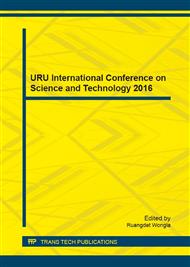p.114
p.121
p.126
p.131
p.137
p.143
p.153
p.159
p.165
Production of Activated Carbon from Moldy Damaged Tamarind-Pod
Abstract:
This research studied production of activated carbon (AC) derived from tamarind pods damaged by mold. Folk wisdom kiln which manufactured from an oil tank size of 200 L was used for pyrolysis and carbonization of tamarind pod derived from sweet and sour tamarinds. The AC was produced by using chemical activation and thermal activation at the optimal condition. Then the physical and chemical properties of the AC were investigated. From the study, it was found that optimal condition for charcoal carbonization of the tamarind pod was 400 °C for 4 hrs. The optimal condition for thermal activation was 600 °C for 1-2 hrs. The phosphoric acid (H3PO4) showed higher effectiveness for activation than distillation water (H2O), potassium hydroxide (KOH) and zinc chloride (ZnCl2). The produced AC has specific surface area of 851.58-910.31 m2/g (BET Theory), a pore volume of 2.24-2.32 cm3/g with an average pore radius of 50.90 to 52.53 Å, iodine number of 613.9-654.8 mg/g, phenols adsorption of 61.7-83.1% and apparent density 0.4528 g/cm3. The results from proximate analysis shown that the AC has the moisture content of 6.81-7.54% (wt), the ash content of 6.58-7.31% (wt), the volatile matter of 38.26-40.12% (wt) and the fixed carbon of 52.57-55.16% (wt). The performance of the AC for acetic acid adsorption according to the Langmuir and Freundlich isotherm exhibited a monolayer adsorption isotherm and the AC adsorbed the acetic acid well and strength. Therefore the produced AC can be further used for filter material in small water treatment.
Info:
Periodical:
Pages:
137-142
Citation:
Online since:
October 2016
Authors:
Keywords:
Permissions:
Share:
Citation:


